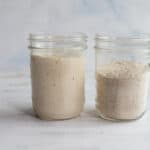How to Rehydrate Sourdough Starter
Learn how to rehydrate sourdough starter with this foolproof step-by-step guide. Transform your dried starter into an active, bubbly culture ready for baking delicious sourdough bread!
Servings: 1 batch of sourdough starter
Ingredients
- 30 grams dried sourdough starter about 1 tablespoon
Instructions
DAY 1:
- Weigh 30g of dried starter flakes and add to a glass pint canning jar. Add 50 grams lukewarm water and try to submerge all flakes by stirring a little.
- Over the next two to three hours, stir the flakes every half hour or so. Eventually they will completely dissolve.
- Once the flakes have disappeared, stir in 30g all-purpose flour. Cover lightly with a kitchen towel, material, or off set lid (don’t tighten it down) and let it sit somewhere warm. Leave it alone for about a day.
DAY 2:
- The next day, take a look at your starter – you're looking for small bubbles. If you see some, or lots, great! If not, no worries.
- Feed your starter with 50 grams flour and 50 grams water. Don't discard any; it's not ready for that yet. We're still trying to build it up. Mix well, cover lightly (I just set a lid on the top without screwing it down) and put your starter back in its warm place. Watch for more bubble activity – this could take anywhere from six to 12 hours.
DAY 3:
- Repeat the set above the third day, cover lightly and let it rest in a warm place.
DAY 4:
- On the 4th day discard all but 50 grams of your starter. Feed it using 100 grams water, 100 grams flour. Stir to mix well. Place, covered, in your warm spot, it will double or triple in size in roughly 3-12 hours. Your starter is now alive and healthy – time to get baking!
DAY 5:
- If your starter is not doubling in 12 hours, repeat day 4 instructions on day 5 (discard and feed). It should be doubling by day 5-7. If it’s not doubling within a week, then it's time to troubleshoot! (See the notes below for more resources.)
Notes
Using Whole Wheat Flour: You can substitute whole wheat flour for all or part of the all-purpose flour, but be aware that whole wheat flour will create a more active starter that may progress faster through the rehydration stages. You might need to adjust your timeline accordingly. Whole wheat flour contains more nutrients that feed the wild yeasts and bacteria.
Don't Rush the Discard Process: Resist the urge to discard starter before day 4. Your rehydrated starter needs time to build up its microbial population. Early discarding can set back the process significantly.
Watch for the Right Bubbles: Not all bubbles are created equal. Look for small, evenly distributed bubbles throughout the starter rather than just large bubbles on the surface. This indicates healthy fermentation activity.
Get Ready to Bake: Your starter is ready to use for baking when it consistently doubles in size within 4-12 hours after feeding and has a pleasant, tangy aroma. It should also pass the float test—a small spoonful should float in water when the starter is at peak activity.
More Sourdough Resources:
🍞 Grab your free Sourdough Starter Kit to get you set up to start baking!
🍞 Then watch these videos for sourdough starter success.
🍞 And finally grab the digital or hardcover copy of my Sourdough Made Easy cookbook with lots of recipes and tips all in one place!
🍞 You can also find loads of recipes here on the blog in the Sourdough Archives.
Nutrition
Calories: 27kcal | Carbohydrates: 6g | Protein: 1g | Fat: 0.1g | Sodium: 0.4mg | Fiber: 0.2g
QR code
Scan this QR code with your phone's camera to view this recipe on your mobile device.
